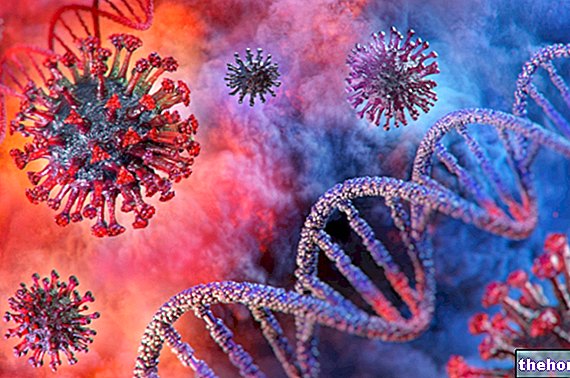Generality
Galactosemia is a rare metabolic disease, transmitted by an autosomal recessive pathway and characterized by the inability to metabolize galactose, a sugar found mainly in milk.
Milk, Lactose and Galactose
The characteristic sugar of milk and dairy products, lactose, is a disaccharide which in the intestine is broken down into glucose and galactose, thanks to the intervention of the lactase enzyme (deficient in milk intolerant subjects). The galactose thus absorbed is rapidly transported to the liver through the portal circulation, where it is metabolized: initially converted into glucose 1-phosphate, it can be transformed into glucose 6-phosphate (then oxidized for energy purposes) or directed towards the synthesis of glycogen.
The conversion of galactose into glucose 1-phosphate occurs thanks to three enzymes, the specific absence of which gives rise to three distinct forms of galactosemia:
- Galactokinase: Galactose is phosphorylated with ATP and becomes galactose 1-phosphate.
- Gallatose 1-phosphate uridyl-transferase (GALT): Galactose 1-phosphate is exchanged for UDP-glucose to produce UDP-galactose and glucose 1-phosphate.
- UDP-galactose 4-epimerase: UDP-galactose is converted to UDP-glucose, which in turn can become substrate in the previous reaction catalyzed by transferase.
Galactosemia symptoms Diagnosis Treatment
Forms of galactosemia and related symptoms
Classical galactosemia due to glucose 1-phosphate uridyl-transferase defect
it is the most common form, which affects - indicatively - one newborn every 40,000 / 60,000. There is an increase in the levels of galactose in the blood and in galactose 1-phosphate in the cells. The increased intracellular concentration of galactose 1-phosphate causes damage and symptoms to the central nervous system, liver and kidneys:
- lethargy, vomiting, loss of appetite (refusal of milk), dehydration, growth retardation;
- haemolytic anemia, jaundice (yellow skin, yellow eyes) generalized and prolonged;
- restlessness, convulsions: if not treated, damage to the CNS can cause brain injury with psychomotor retardation, up to coma;
- tendency to sepsis, especially from Escherichia Coli;
- noticeable increase in the size of the liver (hepatomegaly); later liver cirrhosis;
- impaired renal function;
- edema, ascites;
- development of cataracts;
- ovarian failure;
The symptoms of classical galactosemia can manifest themselves from the first breastfeeding sessions, or in any case in the first week, sometimes even before the screening tests are performed. In the absence of treatment, the disease evolves into a lethal form within a few days or months. for renal and hepatic insufficiency.
Galactosemia due to galactokinase defect
The frequency is lower, equal to about one case in 100,000 newborns. There is an increase in the levels of galactose in the blood and galactitol (toxic), which derives from it via an alternative metabolic pathway. The characteristic symptom is the opacity of the lens, while - since there is no intracellular production and accumulation of galactose 1-phosphate - the other organs involved in classical galactosemia are spared. Psychomotor development is normal, but slight delays are possible cognitive and growth.
Galactosemia due to UDP-galactose 4-epimerase defect
Very rare form. If the defect is isolated, then the enzyme deficiency is limited to red blood cells and leukocytes, the course is mostly asymptomatic or nuanced, and neurological disorders are very rare. If the enzyme defect is generalized, this form of galactosemia manifests itself with severe clinical pictures with an early onset, similar to those typical of classical galactosemia.
Diagnosis
The diagnosis of galactosemia takes place in the context of screening tests, such as the Beutler and Basa test, and the Paigen test, which allow a selective diagnosis of galactosemia when there is a suspicion. It is also possible to measure the levels of galactose-1-phosphate in red blood cells, while evaluating their enzymatic function; the levels of galactose can also be determined in the urine, by monitoring liver and kidney function through specific blood chemistry tests. laboratory tests show high transaminases, hypoglycemia with metabolic acidosis, hyperbilirubinemia, albuminuria, generalized aminoaciduria and loss of salts.
A genetic molecular test will dispel any doubts.
If the pregnancy is considered to be at risk of galactosemia, for example due to the presence of the disease in a family member, the doctor can perform a prenatal screening test through amniocentesis or chorionic villus sampling. The pregnant woman at risk should adopt a diet low in galactose to avoid the risk of fetal harm.
Treatment
the treatment of uncomplicated galactosemia is as simple as it is effective: it is necessary to immediately eliminate all sources of galactose from the diet (milk and dairy products in the first place, replaced with vegetable milks, such as rice or soy), maintaining a sugar-free diet For all life. This intervention must be undertaken immediately in the face of the clinical suspicion of galactosemia, pending a more in-depth diagnosis.
In case of symptoms it is however necessary to meticulously monitor the patient; while the hepatomegaly is reduced, the vomiting ceases and the state of nutrition and growth are normalized, if the therapeutic intervention is not immediate, the brain damage cannot be recovered.
With age, we must pay close attention to the so-called occult sources of lactose and galactose: these sugars, in fact, are present in offal (animal organs such as liver, kidney and brain) and can be added as additives in preserved products, such as cured meats, gnocchi of potatoes, sauces, puddings, bread, some canned foods, baked goods, pastries, soups, milk chocolate and cream candies. Some vegetables such as peas, beans, beets and lentils will need to be consumed in limited quantities, as they contain small amount of galactose.
For UDP-galactose 4-epimerase deficiency, treatment must include a minimum intake of galactose (equal to at least 1.5 g / day).
The prognosis of galactosemia is therefore excellent if dietary control is early and adequate; however, learning, language, motor function and balance disorders (tremors, ataxia) have been reported in children with galactosemia. In females with galactosemia, the risk of developing ovarian failure increases.




























